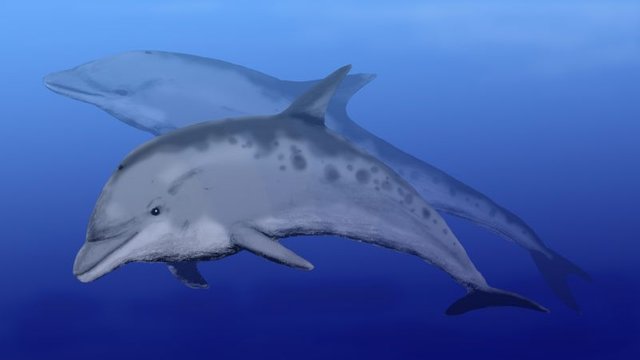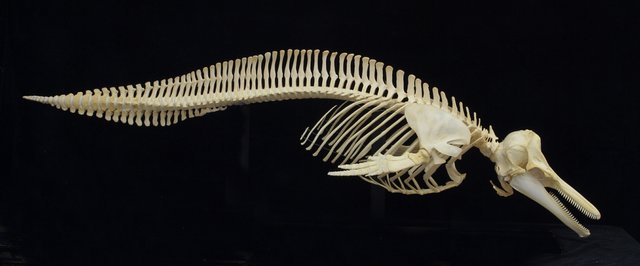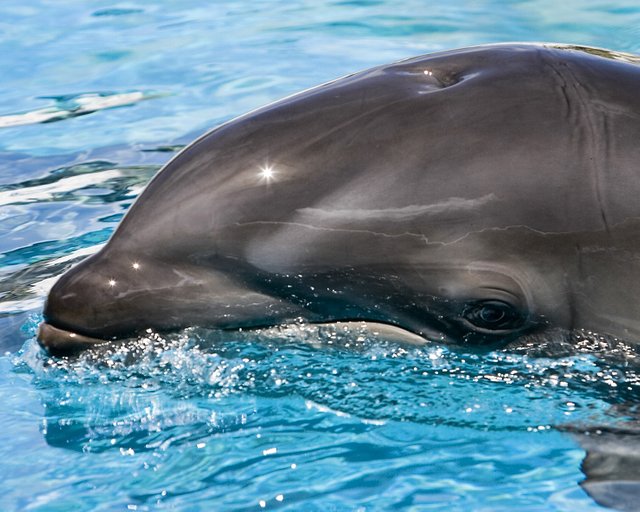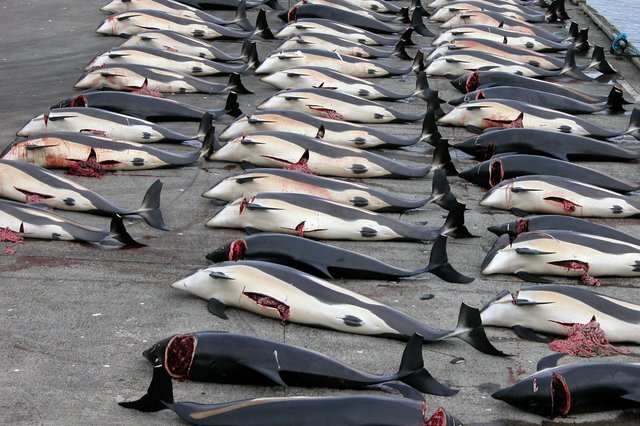Animal Extinction # 1 - #El Delphinidae "a species forgotten by man that will no longer return
Dolphins (Delphinidae), also called oceanic dolphins to distinguish them from platanistoids or river dolphins, are a very heterogeneous odontocete family of cetaceans, comprising 34 species.
They measure between 2 and 9 meters long, with fusiform body and large head, elongated snout and only a blowhole on the top of the head (breathing hole that many marine animals have as contact of air or water with their internal respiratory system). They are strict carnivores.
They are among the most intelligent species that inhabit the planet. They are relatively close to the coasts and often interact with the human being.
Like other cetaceans, dolphins use sounds, dance and jumping to communicate, orient themselves and reach their prey; They also use echolocation. Nowadays, the main threats to which they are exposed are anthropic in nature.

Image source :https://upload.wikimedia.org
Evolution and anatomy
For a long time it was thought that the dolphins, along with the rest of the cetaceans, were descendants of the terrestrial mammals mesoniquios, extinct order of carnivorous ungulates. However, genetic studies have shown that in reality cetaceans (including dolphins) are more closely related to artiodactyls, from which they separated about sixty million years ago; the closest artiodáctilos would be the hippos. It is estimated that during the Eocene (around fifty million years ago), the ancestors of the cetaceans took refuge in the water, similar to the modern tragulids.
Fossil evidence shows that odontocetes appeared in the Miocene. The first known dolphins belong to the family Kentriodontidae. These primitive dolphins already had a developed sense of echolocation and melon organ. The skeletons of modern dolphins present two small bones in the sacral area of the spine, which corresponds to vestiges of the pelvis.

Image source :https://upload.wikimedia.org
Anatomy
By evolutionary convergence its anatomy bears much resemblance to the extinct genus of marine reptiles called Ichthyosaurs.
The species belonging to the family Delphinidae have a fusiform body, adapted to rapid swimming. The fin of the tail, called caudal, is used for propulsion, while the pectoral fins are used for the directional control of the swim. The basic patterns of skin coloring are shades of gray, with greater clarity in the belly and darker ranges in the back. It is often combined with lines and spots of different dye and contrast.
Like other odontocetes, in the head they have the melon, a spherical organ that they use for echolocation. In several species of the family, the jaws lengthen, forming a distinctive thin snout. They have dentition homodonta, with a number of teeth that ranges from 20 to 50 in each jaw. They breathe through a single hole in the top of their head, called a blowhole.
His brain is large, with the cerebral cortex quite developed compared to the average of mammals.

Image source :https://upload.wikimedia.org
Reproduction and sexuality
The copulation of the dolphins happens face to face. The actual act is usually brief, but it can be repeated several times in a short time. Some use a very gallant technique in which males "sing" verses of love in order to conquer the female.
The gestation period varies according to the species. The small tucuxi has a gestation of 11 to 12 months, while for the killer whale the gestation period is around 17 months. They only have one baby. In general, sexual activity begins at an early age, even before reaching sexual maturity. The age of sexual maturity varies according to species and gender.
There are several feeding methods between and within the species belonging to the family Delphinidae. During the first months of life, it feeds on breast milk because it is a mammal. Later it feeds on fish and squid as its main food, but the false killer whale and orca also feed on other marine mammals. Dolphins use very diverse hunting tactics: they often hunt using their speed, but also use echolocation to look for prey buried in the sand. The dolphins that hunt fish grouped in banks form herds and corral them to separate themselves from the rest of the group. Other dolphins corner their prey on the shore of a beach and then take advantage of the waves to capture them, although this is a risky tactic. Orcas and false orcas have many other hunting tactics, due to the wide range of prey they consume. Apart from the tactics already mentioned, they also stalk their prey or hit ice banks to unbalance them.

Image source :https://upload.wikimedia.org
Vocalizations
Dolphins are able to perform a wide range of sounds using nasal air sacs located just below the spiracle. There are three categories of sounds:
Modulated frequency whistles.
- Bursts of impulses sounds.
Clicks (used for Ecolocation).
This skill is called echolocation. The military forces of some countries use the dolphins and this ability to help them find underwater targets. Some scientists have speculated that dolphins also use sounds to send acoustic crashes to kill small prey.
Ecolocation
Echolocation involves the issuance by dolphins of a wide range of sounds in the form of short bursts of sound impulses called clicks and the obtaining of information about the environment by analyzing the echoes they receive back. This ability to use a full range of both high and low frequency sound emissions, combined with very sensitive directional hearing, facilitates extremely accurate echolocation and gives these animals a unique sensory system at sea.
Threats
Natural threats
Except for humans in general, dolphins have few natural enemies. The largest species of dolphins do not have predators. For the smaller species, only the orca (Orcinus orca), and a few shark species such as the bull shark, tiger shark or the great white shark are a potential risk, especially for the young.
Human threats
The environmental pollution of the oceans, seas and rivers is a concern. Pesticides, heavy metals, plastics and other industrial and agricultural pollutants that do not rapidly disintegrate in the environment can cause the reduction of dolphin populations, and cause the accumulation of tissue of high levels of contaminants. Injuries or deaths caused by collisions with boats, especially their propellers, are also common. Various methods of fishing, especially tuna fishing, kill dolphins trapped in nets. In some parts of the world, such as Taiji (in Japan) and the Faroe Islands, dolphins have traditionally been considered as food.

Image source: https://upload.wikimedia.org
Dolphins in legends and mythology
The appearances of dolphins in mythology and legends are numerous, and testify to the relationship between man and dolphins since ancient times. Greek mythology tells that these marine mammals rather than dolphins were men, specifically pirates who tried to sell the god Dionysus as a slave and, as punishment turned them into said cetaceans, and in the same civilization the god Poseidon who exercised dominion over water and the sea, always represented with its characteristic trident and surrounded by dolphins According to another legend, Poseidon convinced Amphitrite to marry him by sending him a dolphin.
In the Chilote mythology of Chile, it is said that there is a mythological being known as Cahuelche, which was originally a human being that was magically turned into a sea creature of very similar appearance or identical to the dolphin species called tonina. However, the Cahuelche would be much more intelligent than the animals of this species and the sound that would emit would be different from the one of these dolphins; and it would have a meaning that is magically understandable to human beings.
Bibliography :
Marta R. Smith, Mahmood S. Shivji, Victor G. Waddell and Michael J. Stanhope (1996). «Phylogenetic Evidence from the IRBP Gene for the Paraphyly of Toothed Whales, with Mixed Support for Cetacea as a Suborder of Artiodactyla». , WI [. B & l. Evnl. (in English) 13 (7): 918-922.
University of California, Berkeley (February 7, 2005). «UC Berkeley, French Scientists Find Missing Link Between The Whale And Its Closest Relative, The Hipp» (in English). ScienceDaily Retrieved on February 14, 2011.
Ian Sample (December 19, 2007). «Whales may be descended from a small deer-like animal» (in English). Guardian Unlimited. Retrieved on February 14, 2011.
I will upvote and resteem your last blog post to my 36,000+ followers for free if you reply to this comment. Follow @a-0-0
Thank you for your contribution. Dont forget to link references and sources when applicable!
=======================================================================================
This post was upvoted and resteemed by Steemgridcoin with the aim of promoting discussions surrounding Gridcoin and science.
This service is free. You can learn more on how to help here.
Have a nice day. :)